The chimps spend a lot of time looking for food on their own this time of year.
Annie:
They love to eat grass, dandelion leaves, prickly lettuce, mustard, and many other wild plants, as well as the bamboo and fir trees that we have planted.
Negra:
Sometimes they sit down and eat them outdoors; other times they collect them and return to the greenhouse.
Missy:
Every once and a while they find something new that we haven’t seen them eat before, or that we didn’t even know was growing on the hill. And when they do, it sends us racing to the computer in a panic to figure out what they’re eating and to make sure it’s safe!
This morning, while the other chimps were munching on grass, Jody seems to have found herself some wild rose – a new one to us. She’s by far the most adventurous eater of the group and she will go to great lengths to eat small amounts of certain plants.
Wild chimps are known to self-medicate, a behavior known as zoopharmacognosy. Some swallow Aspilia leaves whole to treat parasites, others eat clay to ease an upset stomach. This type of behavior is most likely culturally acquired, and chimp culture is not something the Seven ever got to experience in the lab. And of course there is almost no overlap between the plants found across equatorial Africa and the plants found on Young’s Hill, so it’s doubtful that they have any type of innate knowledge of which particular plants to eat. But sometimes I’m struck not just by the type of plants they’re eating, but by the way in which they eat them. If you’re hungry and you want to eat grass, you might as well just stuff your face, as Burrito so happily demonstrates here:
But we occasionally see the chimps carefully swallowing a single blade of grass at a time, even carrying that single blade from the top of the hill back to the greenhouse. And sometimes, instead of chewing the grass first, they fold it up like an accordion and swallow it whole, like wild chimps do with Aspilia.
Is it possible for captive chimps to learn a basic form of self-medication on their own? The Seven are routinely screened for parasites, so it’s highly unlikely that they are knowingly treating a parasitic infection as their wild counterparts do. But as is the case with so much that fascinates us about chimps, where intelligence, instinct, curiosity, and culture are inextricably interwoven into complex patterns of behavior, it certainly leaves you wondering…
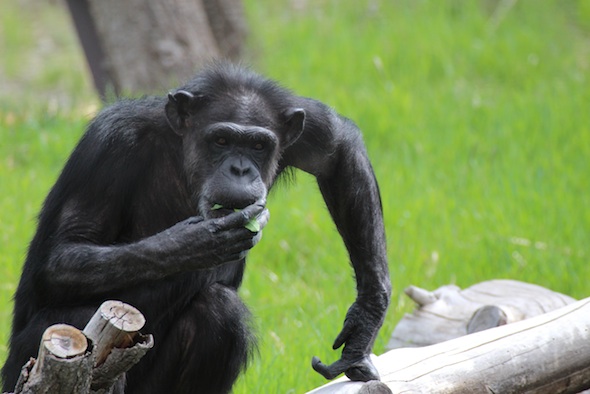
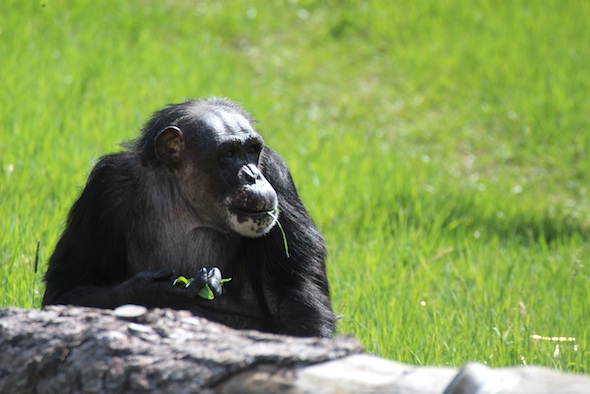
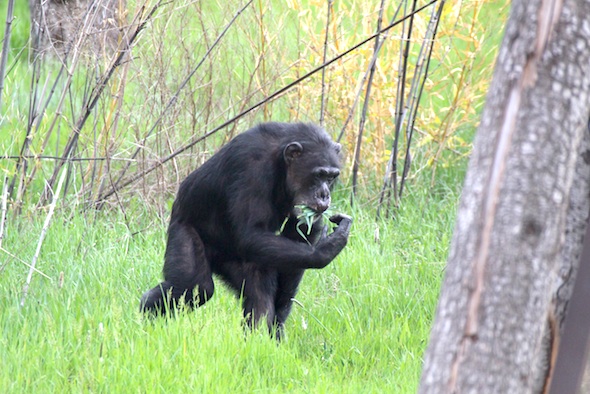
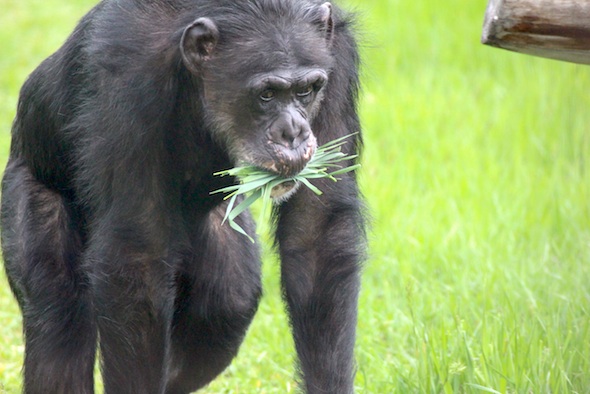
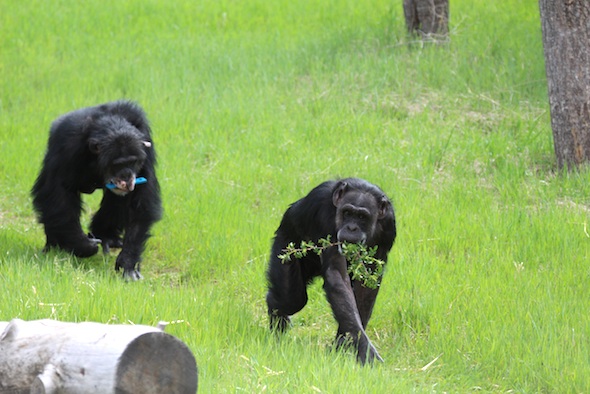
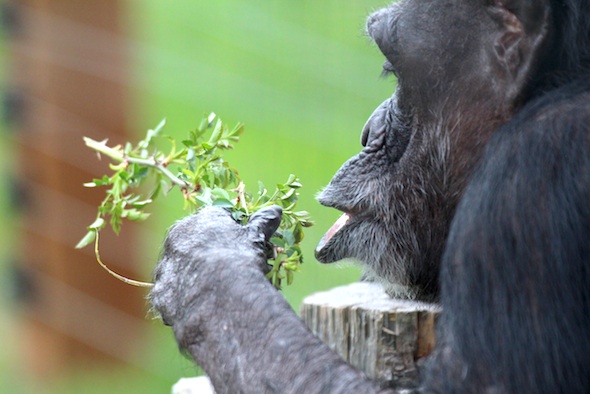
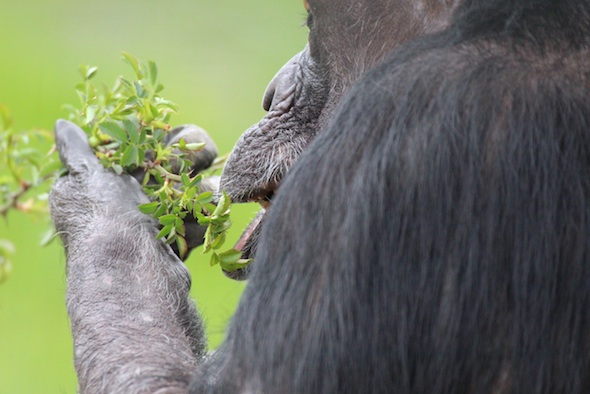
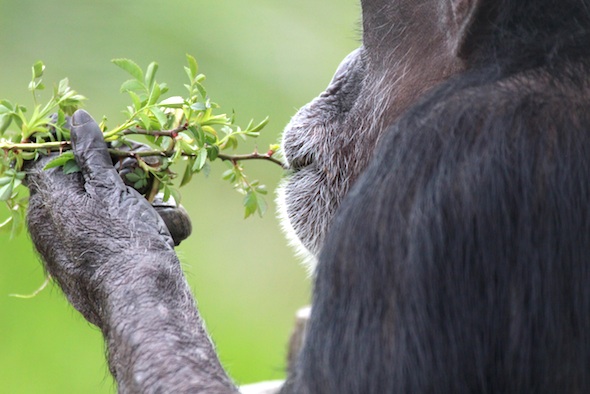
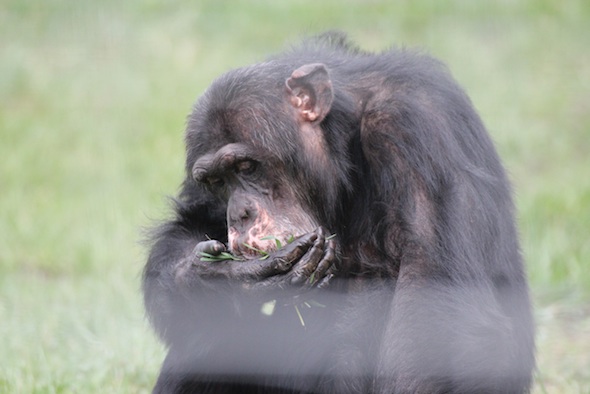
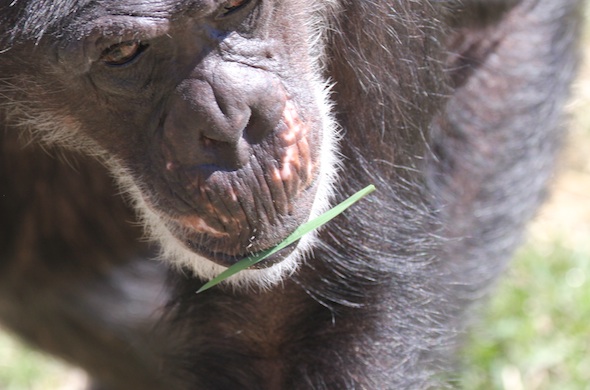





What about asking Jane Goodall or some other wild chimp expert about what chimps eat in the wild for self-medication and if it can be replicated here, at least in pots. I’m up for growing whatever they need!
Hi Meg – A lot has been published on the subject, most notably from Michael Huffman at Kyoto University. We could certainly try growing some Vernonia amygdalina because it can be bought off of Amazon, and it would be interesting to see what the chimps think of it. But the thing is, the wild chimps are treating active parasite loads with bitter pith and Aspilia, and they are eating clay to counteract the high amount of tannins in their diet. The Seven don’t have high parasite loads and they aren’t eating a lot of tannins, so they really have no need for the same medicines that their wild counterparts consume – at least the ones that have documented therapeutic value. But who knows what else they are eating for reasons we have yet to determine?
And not all self-medication is targeted to specific illnesses – dogs are thought to eat grass when their stomachs are upset, or possibly to prevent stomach upset in some cases, so the chimps might also be eating some plants just because they are leafy, in which case it wouldn’t matter what species of plant they are.
As always J.B., this was fascinating and leaves me wanting to ask so many questions. But I will only ask this : Was the wild rose plant that Jody enjoyed a danger to her (besides eating those nasty little prickly thorns!!)? What did you discover?
We have wild rose (Multiflora Rose) that grows everywhere where I live. It was used in the 1930’s as fencing for livestock (dairy cows mostly) and now it is all over the place and impossible to get rid of! Wickedly invasive so beware if your version is similar!
(I’m still laughing at Burrito eating fistfuls of grass as compared to Missy with her single green blade! I so enjoy your descriptions of Mr. B.)
No, no danger. I believe that this is Rosa woodsii, which was actually consumed as food and medicine by Native Americans. This is not to imply that Jody somehow knows to use it as medicine, only to say that it is known to be safe. But interestingly, the chimps seem to avoid the plants that have any trace of toxicity. At first we were worried about the mountain lupine that grows on the hill, because it is mildly toxic. We mow it as soon as it sprouts up in the spring but a few plants always find a way to escape eradication. And the chimps have never been observed eating it. My guess is that many plants evolve toxicity to prevent being eaten, and just as poisonous snakes have coloring that signals their danger, these plants contain compounds that make them taste bad to signal their toxicity.
Luckily, we don’t have any plants around here that cause acute toxicity, so the chimps would have to eat a lot of lupine to get sick, and there’s a chance that at one point they ate a little bit, felt a bit of an upset stomach, and then never ate it again.
Fascinating facts, incredible photos and captions to accompany them. I’m so -oooo-oooo-oo addicted to your daily blogs.
That is really interesting and thought provoking.